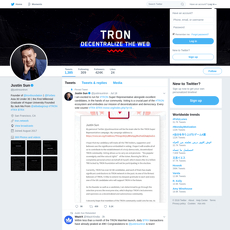Gavin Andresen Review
Gavin Andresen
twitter.com
Gavin Andresen review guide: everything you need to know about his Twitter, legacy, and why it still matters
Ever scroll past a Gavin Andresen tweet and wonder if you’re missing something important—or just old drama? If you’re trying to figure out what to pay attention to and what to ignore, you’re in the right place.
This guide is your shortcut to clear context: who Gavin is, why his opinions still get attention, what happened in the block-size wars, how he thinks about altcoins, and what his Twitter means for you today. No hero worship, no hit piece—just straight answers and a practical way to read his posts without getting lost.
Too many takes, not enough clarity
Newcomers hear “early Bitcoin dev,” “XT,” “block size,” and sometimes “that Craig Wright thing,” then get hit with old blog posts and tweets pulled out of context. It’s messy. You’ll see hot takes on Reddit, screenshots on X, and decade-old quotes resurfacing like they were posted yesterday.
- Context whiplash: posts from 2013–2016 get treated like fresh opinions. Social feeds collapse timelines, so past views look current.
- Terminology overload: Bitcoin XT, block-size limits, sidechains, L2s—most threads assume you already know the history.
- Signal vs noise: occasional tweets become lightning rods, even if they’re just a passing thought.
This isn’t unique to crypto. There’s a well-documented social media problem where context gets stripped away and the spiciest takes spread faster. One widely cited study in Science found false or sensational news outpaces truth on Twitter/X, reaching more people more quickly (Vosoughi, Roy, Aral, 2018). Add crypto’s tribal debates and you’ve got a recipe for confusion.
Old tweets + no context = bad calls. This guide fixes that.
I’ll make this simple
Here’s the plan I’ll follow so you get clarity without a rabbit hole:
- Clean timeline: what happened, when, and why people still care.
- What he actually argued: the stance on scaling, usability, and trade-offs—in plain English.
- How to read his Twitter today: what’s useful, what’s not, and how to use it in your research.
- Practical takeaways: lessons you can apply to building, investing, or just staying informed.
Who this is for
- Builders: you want to learn from early design choices without repeating past mistakes.
- Investors: you want a lens to judge narratives around scaling, fees, and decentralization.
- Curious Bitcoiners: you want context without drama, agendas, or tribal spin.
What you’ll get
- Quick summaries of key moments so you don’t need to piece together old forum posts.
- Balanced context that acknowledges both sides of the big debates.
- Useful links to original sources, blog posts, and threads for your notes.
- Zero hype: this isn’t about signals to trade on—it’s about understanding the terrain.
How I’ll keep it balanced
- No cherry-picking: I’ll reference original sources where possible (blog posts, GitHub, archived talks).
- No dunk culture: the goal is clarity, not scoring points for any tribe.
- Present vs past: I’ll separate historical positions from what he posts now.
Why this matters right now
Crypto history doesn’t sit in a museum—narratives shape markets, influence policy, and guide builders. When someone who maintained Bitcoin early on posts a thought about scaling or developer incentives, even a short tweet can ripple across conversations. Understanding the why behind those posts helps you avoid knee-jerk reactions and make smarter decisions.
So, who exactly is Gavin Andresen, and why do his opinions still echo across Bitcoin and beyond? Let’s answer that next.
Who Gavin Andresen is (and why he still matters)
If you ever wished you could’ve “been early,” picture this: in 2010 you could click a button and get 5 BTC. That wasn’t luck—it was the original Bitcoin Faucet Gavin Andresen built to help people try Bitcoin with zero friction. Around the same time, Satoshi handed him the keys to maintain Bitcoin’s code.
“I’ve moved on to other things. It’s in good hands with Gavin and everyone.” — Satoshi Nakamoto (2011)
That sentence shaped Bitcoin’s early path. Gavin became a central organizer of code reviews, releases, and practical decisions that kept the network usable while it was still fragile and weird. He also stepped into the public arena—writing, speaking, and explaining Bitcoin to curious developers, skeptics, and yes, even government audiences.
Key contributions in plain English
- Lead maintainer after Satoshi: Gavin coordinated code reviews, merged changes, and shipped releases—boring work on paper, but the difference between a hobby project and resilient money. You can still see his historical work on Bitcoin Core’s commit history.
- Pay-to-Script-Hash (BIP16): In 2012 he proposed and helped activate BIP16, which made multi-signature and complex spending conditions practical. If you’ve ever used a Bitcoin address starting with “3,” that’s P2SH—less complexity for users, more flexibility under the hood.
- Bitcoin Faucet (2010): His faucet gave out 5 BTC per claim at launch, lowering the psychological barrier to try Bitcoin when it was worth pennies. It wasn’t marketing fluff; it was an on-ramp that seeded early communities and experiments with real coins. Primary source: his Bitcointalk post.
- Security and stability work: Early Bitcoin needed guardrails. Gavin pushed pragmatic fixes like anti–DoS safeguards and checkpoints to protect the network while it grew. That custodial mindset—ship, then harden—helped Bitcoin survive its first chaotic years.
- Payment Protocol (BIP70): Co-authored with Mike Hearn, BIP70 tried to make paying merchants less error-prone. It saw real-world adoption, and later the ecosystem moved away from it (Core removed support in v0.20)—a solid example of him optimizing for usability, even when the long-term consensus evolved.
- Public educator and early ambassador: He didn’t hide from tough rooms. In 2011 he even briefed intelligence folks about Bitcoin—documented in his own words: “Bitcoin and me (the CIA, too)”. Like it or not, those conversations helped the wider world take Bitcoin seriously.
- Founding member of the Bitcoin Foundation: He served as Chief Scientist in 2012, giving the nascent industry a public-facing technical voice during a time when there were few.
What “maintainer” actually meant back then
- Guard the codebase: Say “no” way more than “yes,” and keep changes sane.
- Balance risk: Security first, but without freezing real-world usage.
- Coordinate upgrades: Herd cats across mailing lists, IRC, and forums to get safe rollouts.
- Translate complexity: Turn arcane technical trade-offs into decisions builders and businesses could act on.
Why his voice still gets attention
- He worked directly with Satoshi: Not many people did. That proximity gives his commentary historical context you can’t fake. The final message from Satoshi—“it’s in good hands with Gavin”—is part of the public record.
- He argues from shipped software, not vibes: Whether you agree or disagree with him on scaling, he speaks in engineering trade-offs. For a clear sample, read his 2015 post “Why increasing the max block size is urgent.”
- He shaped how debates are framed: Throughput vs decentralization, fees vs accessibility, complexity vs security—these lines didn’t appear by accident. His writing and maintenance history helped define them.
- His fingerprints are still in your wallet: P2SH made everyday features (like multisig) practical without forcing users to learn script arcana. That kind of “invisible” design sticks.
Quick timeline snapshot
- 2010–2011: Launches the Bitcoin Faucet; becomes the lead maintainer after Satoshi; posts the famous “CIA” note (2011); Satoshi’s message: “It’s in good hands with Gavin.”
- 2012–2014: Pushes BIP16 (P2SH); serves as Chief Scientist at the Bitcoin Foundation; co-authors BIP70 to streamline payments.
- 2015–2016: Focuses on scaling usability; supports alternative implementations like Bitcoin XT; last Core contributions appear in early 2016 (commit history).
- 2017–today: Quieter on Bitcoin Core itself, but still writes and comments occasionally—see his thought experiment, “A possible BTC future” (2021), and his Twitter for periodic perspective.
Why this matters to you right now
Gavin’s record isn’t about nostalgia; it’s a template for thinking. He pushed features that improved everyday usability, took on the unglamorous work that prevents disasters, and argued—loudly at times—that Bitcoin should stay usable for normal people. Whether you agree with every call he made, you’ll learn a lot by studying how he weighs trade-offs.
So what happens when that pragmatic, product-minded engineer runs straight into Bitcoin’s most polarizing traffic jam—block space? Keep reading: the next part breaks down the block-size war and what it meant for him (and for everyone using Bitcoin).
The block-size war: what happened and why it mattered to Gavin
At its core, this fight was simple to say and hard to resolve: should Bitcoin keep small blocks and scale with layers, or raise the block limit to fit more transactions on-chain? One side feared centralization if blocks grew too large. The other feared pricing out everyday users if capacity stayed small.
Both sides had a point. But the stakes were emotional because the answer defined who Bitcoin was for and how quickly it could grow.
- Small blocks: protect decentralization by keeping node costs low; scale via upgrades like SegWit, compact blocks (BIP 152), and Layer 2s like Lightning.
- Bigger blocks: protect user experience by adding capacity on-chain to keep fees stable and confirmations fast.
“Scaling isn’t just code. It’s a choice about who gets to use Bitcoin today, and who has to wait.”
Gavin’s position and Bitcoin XT
Gavin pushed for more on-chain capacity. He supported a hard fork to raise the block size limit and backed Bitcoin XT—an alternative client created with Mike Hearn—to test and ship that change. XT implemented BIP 101, which proposed moving to 8 MB blocks with a schedule to gradually increase over time. The goal: reduce the risk of congestion and keep fees reasonable so more people could actually use Bitcoin.
If you weren’t around then, here’s what the “UX” argument looked like in real life:
- When demand spiked (think late 2017), mempools exploded and fees shot into the tens of dollars for a simple transaction—check historical charts on BitInfoCharts.
- That’s great for security budget arguments, not so great if you’re sending $20 to a friend and the fee is the same as your lunch.
Gavin’s view was pragmatic: if the base layer couldn’t handle more transactions in busy times, people would look elsewhere. He wasn’t against technical improvements like compact blocks (BIP 152) or Layer 2s; he just believed the base layer also needed elbow room, and he was willing to use a hard fork to get it.
Why the pushback? Research and ops folks worried that larger blocks would increase orphan rates and bandwidth/storage demands, raising the barrier to running a node. Papers like Gervais et al. (2016) explored how block size and propagation interact with security. Engineers were also improving propagation with things like compact blocks and FIBRE, reducing the need to grow limits quickly.
XT never reached the activation threshold. The community chose a different path: SegWit, incremental optimizations, and then Lightning for higher throughput without raising the 1 MB cap (post-SegWit, block “weight” effectively increased capacity without a simple size bump).
Why he stopped contributing in 2016
Per public repos, his last contributions to Bitcoin Core are dated February 2016. Then, in May 2016, he publicly stated he believed Craig Wright’s claim of being Satoshi—a claim that was widely disputed. As a precaution, maintainers removed his commit access; see coverage from Bitcoin Magazine. From there, he stepped back from Core development.
That episode gets the headlines, but it sits on top of something older: a deep rift over how Bitcoin should scale and how to govern hard forks. By 2016, those disagreements were already exhausting. The trust issue accelerated a break that was probably inevitable.
What this means for you today
It’s easy to read the history as “one side won.” The truth is more useful than that. You can use this debate as a practical lens:
- User experience vs. decentralization: Bigger base-layer blocks make payments smoother in the short run; smaller blocks protect permissionless access to running nodes. Both goals matter. Which one does your product or thesis prioritize?
- Technology and timing: SegWit plus BIP 152 cut propagation overhead; Lightning handles high-frequency payments off-chain. This path validated the “layered” approach—but fee spikes still happen in busy markets. Are your assumptions robust when the mempool is jammed?
- Market experiments as data: Chains that raised block limits aggressively became live case studies. Bitcoin Cash went for bigger blocks with modest adoption; Bitcoin SV pushed to very large blocks and faced centralization concerns and stability incidents (e.g., multiple 51% attacks reported in 2021). Read the operational lessons, not just the narratives.
- Security budget and fees: The fee market is now a pillar of Bitcoin’s long-term security model. Higher demand makes fees spike—and that prices out some users. That tension never fully goes away; you plan around it.
- Governance reality check: Hard forks aren’t just code merges; they are social coordination at Internet scale. If your roadmap depends on “a simple hard fork,” budget for years, not months.
I still think about a simple moment from 2017: friends trying to send $50 during peak mania, staring at fee calculators and just giving up. That’s the kind of experience Gavin wanted to avoid. You can disagree with the remedy, but the pain he called out was real—and it still pops up when the mempool is on fire.
Here’s the thread that keeps pulling us forward: if base-layer conservatism limits what you can do right now, where does the energy for new features and experiments go? Sidechains? Or does it spill into entirely new ecosystems like Ethereum? Let’s look at that next.
Gavin on altcoins, Ethereum, and sidechains
Gavin Andresen isn’t anti-altcoin; he’s anti-pointless token launches. His north star is simple: keep innovation as close to Bitcoin as possible, and only mint a new currency if there’s a strong, unavoidable reason. If you can get the same result with Bitcoin as the asset and a different execution layer (sidechain or Layer 2), that’s the better path.
That lens explains a lot of his takes over the years. He respects experimentation, but he’s wary of fragmenting liquidity and security for hype. When a new idea lands, his first instinct is to ask: could this live as a Bitcoin-adjacent system without inventing yet another coin people have to learn, store, and trade?
His core take on new coins
- Purpose over press releases: If the new token isn’t essential to the system’s security or economics, skip it. Use BTC as the currency.
- Prefer sidechains when you can: Build features next to Bitcoin so you inherit its asset and brand, and avoid fragmenting users.
- Minimize new trust assumptions: Every new L1 or token adds a new security model, governance process, and “unknown unknowns.” Make sure it’s worth it.
Real-world examples make this clear:
- Rootstock (RSK) uses RBTC, a 1:1 pegged version of BTC, to power EVM-compatible smart contracts (rootstock.io). No new speculative currency needed; BTC pays for gas.
- Liquid moves BTC at exchange speed with confidential transactions on a federated sidechain (blockstream.com/liquid), using L-BTC pegged to Bitcoin.
- Stacks brings smart contracts “anchored” to Bitcoin, but with its own token and security model. That’s a different trade-off set—useful for some builders, but not what Gavin pushes first.
The Ethereum “warning” to Bitcoin
When Ethereum took off, Gavin treated it like a signal, not a rivalry. Developers flocked to where they could build fast, deploy contracts, and iterate. That’s a market truth he often points to: utility wins.
“Users follow utility.”
It’s not just vibes. Multiple years of Electric Capital’s Developer Report show Ethereum leading in active developers, with EVM tooling and L2s accelerating experimentation (electriccapital.com/developer). Meanwhile, the biggest stablecoin story says the same thing out loud:
- Tether started on Bitcoin’s Omni layer, then moved where fees and UX worked: Most USDT supply now lives on Ethereum and Tron because it’s cheaper and faster for transfers (tether.to/transparency).
Gavin’s takeaway: if Bitcoin ignores important use cases and developer experience, other chains will capture that energy. The good news is that “close to Bitcoin” routes exist and keep getting better—think Taproot Assets for issuing assets that can route over Lightning, or sidechains that let apps run while keeping BTC as the money.
Sidechains: what “close to Bitcoin” really means
Sidechains are the pragmatic middle ground: experiment freely, keep Bitcoin safe.
“Innovation can happen on sidechains without putting the main network at risk.”
— inspired by the Sidechains whitepaper (blockstream.com/sidechains.pdf)
- Federated sidechains (e.g., Liquid): fast, privacy features, managed by a federation of reputable entities.
- Merge-mined/pegged designs (e.g., RSK): reuse Bitcoin’s mining power and peg BTC in/out.
- Proposed full two-way pegs (e.g., Drivechains, BIP-300/301): ambitious but politically and technically debated.
If you’re hearing Gavin’s voice in your head, it probably says: push the frontier, but don’t compromise base-layer security—and don’t make users juggle needless tokens.
Case studies in 30 seconds
- Stablecoins: Omni on Bitcoin couldn’t keep up on fees/UX; Ethereum and Tron won transfers. Response near Bitcoin: Taproot Assets aims to bring stable-value assets back into the Bitcoin orbit.
- Smart contracts: Ethereum/EVM dominated because ship speed matters. Bitcoin-adjacent path: RSK and projects like Sovryn build DeFi while using BTC as money.
- NFTs/collectibles: Ethereum’s ERC‑721 set the standard. On Bitcoin, Ordinals and BRC‑20 showed that when you open the door, creators rush in—noise and all (ordinals.com).
Practical checklist before you mint a token
- Purpose: What problem requires a brand-new currency vs. BTC as the asset?
- Utility: Can users do something they clearly couldn’t before?
- Security model: Who can freeze, redo, or censor? What are the failure modes?
- Decentralization trade-offs: Are you okay with a federation, or do you need permissionless miners/validators?
- Could this be a sidechain/L2? If yes, that’s probably the path Gavin would nudge you toward.
- Fees and UX: Will users actually stick around when the network gets busy?
- Exit ramps: Is it trivial to move value back to BTC without trust gymnastics?
If you’re building, this checklist will save you time and community trust. If you’re investing, it filters out 90% of noise.
One last thought: the market already told us what it values—speed to ship, real utility, and sane security assumptions. The question is, how does Gavin frame that balance today, post-scaling wars and post-Ethereum’s rise? Ready to see how he phrases it in his feed and what to watch for in his posts next?
Reviewing his Twitter: what to expect from @gavinandresen
Gavin’s Twitter isn’t a firehose; it’s a measured stream. Expect occasional posts with a pragmatic tone, a bit of reflection, and the kind of engineering-first perspective that helped shape early Bitcoin. You’ll see links to longer thoughts on his blog, notes on trade-offs, and sometimes a look back at how we got here. It’s not “breaking news.” It’s context you can actually use.
"Follow for perspective, not for permission."That’s the mindset that keeps you clear-headed on crypto timelines.
If you’re tired of loud threads that age like milk, his lower-volume style can feel like a reset button. It’s calmer. Less FOMO. More signal.
How to read his tweets productively
I treat each tweet or thread as a pointer, not the destination. Here’s the simple workflow I use:
- Start with the theme, not the sentence. Is he pointing at scalability, UX, decentralization risks, or incentives? Label it. Themes outlive takes.
- Click through. If he links to a blog post, read that first. His longer posts tend to carry the nuance his tweets hint at. You can often find them on gavinandresen.ninja.
- Cross-check the claims. If he references policy or protocol ideas, compare them against BIPs, sidechain docs, or recent fee/mempool data. The point isn’t to “agree”—it’s to understand the trade-offs.
- Never treat a tweet as a trading signal. Research consistently shows attention-driven buying hurts performance. See Barber & Odean’s study on how headlines lure retail into bad timing (SSRN). And false news spreads faster than truth on Twitter, so resist the “viral = valid” trap (Science, 2018).
- Read the replies for extra context. Early devs and researchers sometimes add gems in the comments. Filter out the noise—look for sources and code, not zingers.
Example in practice: when he shares a future-facing post (e.g., a hypothetical about how Bitcoin usage could evolve), I map the assumptions he’s making—fees, throughput, user behavior—and compare them with current L2 adoption and tooling. That’s where the value is: testing your model of the world.
What not to expect
- No daily charts or price targets. He’s not your momentum feed.
- No “breaking” dev updates. He’s not actively shipping to Bitcoin Core today.
- No hot takes on every headline. Silence often means he’s not interested in the news cycle.
- No promotional hype. If you’re looking for giveaways or “alpha,” this isn’t it.
Turn a single tweet into usable research (my 5-step template)
- Save the tweet URL and any linked posts to your notes app (Notion/Obsidian works great). Add tags like fees, L2, sidechains, governance.
- Summarize the point in one sentence: “He’s arguing X because Y risk outweighs Z upside.”
- Attach one corroborating document (BIP/spec/research). If you can’t find one, mark it as an opinion to revisit.
- Decide next actions: read a specific BIP, benchmark an L2, re-check mempool/fee data on a busy day.
- Review in a weekly slot. If your thinking didn’t change, great—you hardened it. If it did, write why.
This turns a 30-second scroll into compounding knowledge instead of fleeting dopamine.
Notification setup that respects your focus
- Follow @gavinandresen and hit the bell, but set alerts to Highlights so you only see notable posts.
- Add him to a private “Signal” List with 5–10 other long-term thinkers. Open that List—not your Home feed—when you want clarity.
- Log any thread you find actionable into a dedicated “Research Inbox” so good ideas don’t vanish in the timeline.
One more emotional tip: when a tweet challenges your assumptions, resist the urge to “win” in the replies. Save it, sit with it, and stress-test it against your framework. That’s how you make progress without burning energy on debates that don’t move your work forward.
Curious how to turn those saved notes into real decisions—like whether your product should ship a token, use an L2, or aim for a sidechain instead? I’ve got a simple, practical framework for builders and investors next. Want the one-page checklist I actually use?
How to use Gavin’s ideas in your day-to-day crypto work
Here’s how I actually apply Gavin’s lens when I’m building, investing, or sanity-checking Bitcoin projects: start with a real user problem, favor simplicity and security, and only reach for new tokens or on-chain changes when they’re truly necessary. It’s a practical way to cut through noise and ship things people use.
For builders: ship the fix, not the feature list
Gavin’s stance pushes you to prove necessity first. If your core value can be delivered without a new token or a custom L1, do that. Tokens, custom consensus, and novel cryptography all raise your attack surface and slow you down.
- Token test: If your flows (payments, access, governance) work with Bitcoin plus a sidechain or Lightning, you probably don’t need a token. Keep the economics simple and focus on UX and reliability.
- Design for fee volatility: Bitcoin fees can spike when blockspace heats up (we’ve all seen it). Build for batching, RBF/CPFP, and Lightning or other L2s for frequent, small payments. The teams that planned for this kept users during congestion.
- Pick boring, proven components: Battle-tested tooling beats shiny, brittle stacks. Fewer moving parts = fewer bugs, fewer attack angles, easier audits.
Example that ages well: a non-custodial wallet using Lightning for microtransactions and sending larger, less frequent settlements on-chain. No token, tight UX, clear fee model. This matches the “use layers when they make sense” mindset.
Example that often goes sideways: launching a payment app with a governance token “just in case.” Regulatory risk increases, incentives get weird, and most users don’t want another asset to track. If you can solve it with Bitcoin + an L2 or a sidechain, do that first.
My rule of thumb: if you can build it without a token, build it without a token—prove usage, then consider incentives later if the model truly needs them.
Backed by experience and research: teams that optimize for simplicity and security tend to ship faster and survive longer. Developer ecosystem reports (like Electric Capital’s) consistently show that real traction sticks where builders solve clear problems and reduce complexity, not where they multiply variables.
For investors: prefer utility and sustainable scaling
I filter projects through a very short list inspired by Gavin’s trade-off mindset.
- Does it fix a real pain right now? Payments that actually settle, compliance that actually works, or privacy that actually protects—today. Avoid “once we scale” promises with no path.
- Layer optionality: Can it operate on Bitcoin L2/sidechains or interoperate across layers? Composability and exit options reduce fragility.
- Security assumptions: What new trust is introduced? Are there multisigs, federations, or new validators? Fewer novel assumptions = less tail risk.
- Node costs and decentralization: If their plan increases block production or data load so much that running a validating node becomes data-center territory, that’s a red flag. Studies of block propagation show that pushing bigger blocks raises orphan risk and subtly centralizes the network.
- Token necessity: If a token exists, can they justify it beyond fundraising? Look for concrete utility, transparent distribution, and clear demand drivers.
- Real usage vs. vanity metrics: Cross-check headlines with on-chain usage, fee revenue, and developer activity (think: independent dashboards, client diversity, contributor counts).
When I apply this, I end up favoring products that lean on Bitcoin for settlement, use sidechains or Lightning for throughput, and keep incentive design honest. It’s not maximalism—it’s risk-adjusted realism.
For Bitcoiners: read scaling proposals like an engineer
Gavin’s legacy in the scaling conversation reminds me to ask: what breaks first as we make blocks bigger or protocols more complex?
- Propagation and orphaning: Larger blocks generally take longer to propagate; that increases orphan rates and tends to favor miners with better connectivity—nudging centralization. Classic networking studies in Bitcoin flagged this years ago, and the physics didn’t change.
- Home node reality: If a change makes it meaningfully harder for a regular user to run a node (bandwidth, disk, CPU), the network gets more fragile.
- Fee market behavior: When demand spikes, fees ration blockspace. Plan your ops for that: batch transactions, schedule non-urgent sends, and use L2s for recurring flows.
Practical toolkit I use on busy days:
- Batching and RBF: Consolidate UTXOs when fees are low; use RBF for time-sensitive sends.
- Lightning for frequency: Settle infrequently, transact frequently.
- Sidechains for issuance: If you’re moving issued assets, consider using a sidechain designed for that instead of spamming L1.
Where his takes age well (and where they don’t)
- Age well: Build with purpose, cut complexity, respect security boundaries. These are evergreen and echoed by postmortems across the industry.
- Mixed: He pushed harder for on-chain capacity. The market leaned toward layered scaling (Lightning and sidechains) for throughput while keeping L1 conservative. Still, capacity debates resurface whenever fees spike or new use cases emerge, so understanding both sides is useful.
My quick framework before I back, build, or feature something
- User pain: What exact job is this doing? For whom? How often?
- Layer choice: Could this live on a Bitcoin sidechain or L2 with better security/UX economics?
- Security delta: What assumptions change vs. Bitcoin L1? Who can pause, upgrade, or seize?
- Decentralization impact: Does it raise the cost to validate or exclude smaller participants?
- Token necessity: If the token vanished, would the product still work? If yes, why issue it?
- Fee plan: How do we operate when L1 fees surge? What’s the user path then?
- Upgrade path: Governance, audits, and a rollback plan that doesn’t become a rug lever.
Score each item 0–2 (no/partial/yes). I rarely touch anything below 10/14. It forces clarity and keeps hype from writing the roadmap.
Want the short, straight answers to the most-asked questions about Gavin Andresen—why he left, how he sees altcoins, and what actually matters for you today? I’ll tackle those next. What do you want cleared up in one paragraph?
FAQ: quick answers about Gavin Andresen
Quick, straight answers to the questions I get most. If you want context without the drama, start here.
Why did Gavin Andresen leave Bitcoin?
He stopped contributing to Bitcoin Core in early 2016. He had pushed for raising block limits to keep fees low and throughput higher, and supported Bitcoin XT as an alternative path for that. In May 2016, after he publicly said he believed Craig Wright’s claim of being Satoshi (a claim widely rejected), his commit access was removed as a precaution by maintainers. The bigger picture was long-running disagreements over scaling direction and governance.
- GitHub profile (shows contribution timeline): github.com/gavinandresen
- His post stating belief at the time: gavinandresen.ninja/satoshi
- Report on commit access removal: CoinDesk (May 2016)
What does he think about altcoins?
He’s generally in the “use Bitcoin’s currency if you can” camp, and prefers innovation to happen close to Bitcoin—via sidechains or layers—unless there’s a strong, specific reason for a new token to exist. His north star is utility: if a new coin unlocks something Bitcoin can’t reasonably do, that’s defensible. Otherwise, don’t add a token just to add a token.
Is his Twitter worth following?
Yes—if you’re looking for perspective, not signals. He posts infrequently and tends to share pragmatic takes, experiments, and occasional reflections on trade-offs. That makes it good for historical context and engineering angles, not daily market chatter.
twitter.com/gavinandresen
Did he really believe Craig Wright was Satoshi?
At the time, yes—he said he was convinced by a private demonstration. That claim was widely disputed, and he later expressed regret about how it was handled. Either way, the episode accelerated a loss of trust among Core maintainers.
Useful lens: separate the mistake from the rest of his track record. Early code, leadership, and faucet work stand on their own; the Wright episode was a major misstep.
What did he build in the early days?
The original Bitcoin Faucet, which famously handed out 5 BTC per claim in 2010 to bootstrap a user base—one of the most effective growth hacks in Bitcoin’s history.
- Archive thread: “Free Bitcoins” on Bitcointalk (2010)
Did he talk to Satoshi?
Yes. He was one of the early contributors Satoshi interacted with. You can read preserved emails and forum posts that include references to him.
- The Complete Satoshi (emails and posts): Nakamoto Institute
Did his scaling stance have any technical basis?
Agree or not, it wasn’t hand-wavy. He argued that larger blocks, with improved propagation tech, could keep fees reasonable while serving more users. Research at the time explored the limits of network propagation and orphan rates as blocks grow.
- Early study on block/tx propagation: Decker & Wattenhofer (2013)
- Context on trade-offs from the period: BitMEX Research (historical analyses)
Is he still coding on Bitcoin Core?
No. He hasn’t contributed to Core since 2016. He occasionally publishes experiments and opinions on his personal blog.
- Blog: gavinandresen.ninja
What’s his take on Ethereum?
He’s acknowledged Ethereum’s momentum as a market signal: users follow utility. He’d still rather see most innovation anchored to Bitcoin when it makes sense, but he doesn’t dismiss experiments that clearly solve real problems.
Did he really present Bitcoin to the CIA?
Yes. In 2011 he posted that he was going to brief an intelligence audience. It’s part of the lore because it happened near the time Satoshi went quiet.
- His 2011 note: Bitcointalk post
Is he Satoshi?
No. He has never claimed to be Satoshi and has repeatedly denied it.
What’s the one lesson to keep from his work?
Design around real user pain, be explicit about trade-offs, and don’t ship a token unless it’s the only practical way to make the system work. That lens ages well across cycles.
Wrap-up and next steps
Follow his Twitter for context, not hype. If you’re evaluating a project today, pressure-test it with his simple filters: clear purpose, honest trade-offs, security assumptions you can explain, and no new token unless absolutely required. I’ll keep this guide current on cryptolinks.com and link out to quality primary sources so you can research smarter and skip the noise.
CryptoLinks.com does not endorse, promote, or associate with Twitter accounts that offer or imply unrealistic returns through potentially unethical practices. Our mission remains to guide the community toward safe, informed, and ethical participation in the cryptocurrency space. We urge our readers and the wider crypto community to remain vigilant, to conduct thorough research, and to always consider the broader implications of their investment choices.













